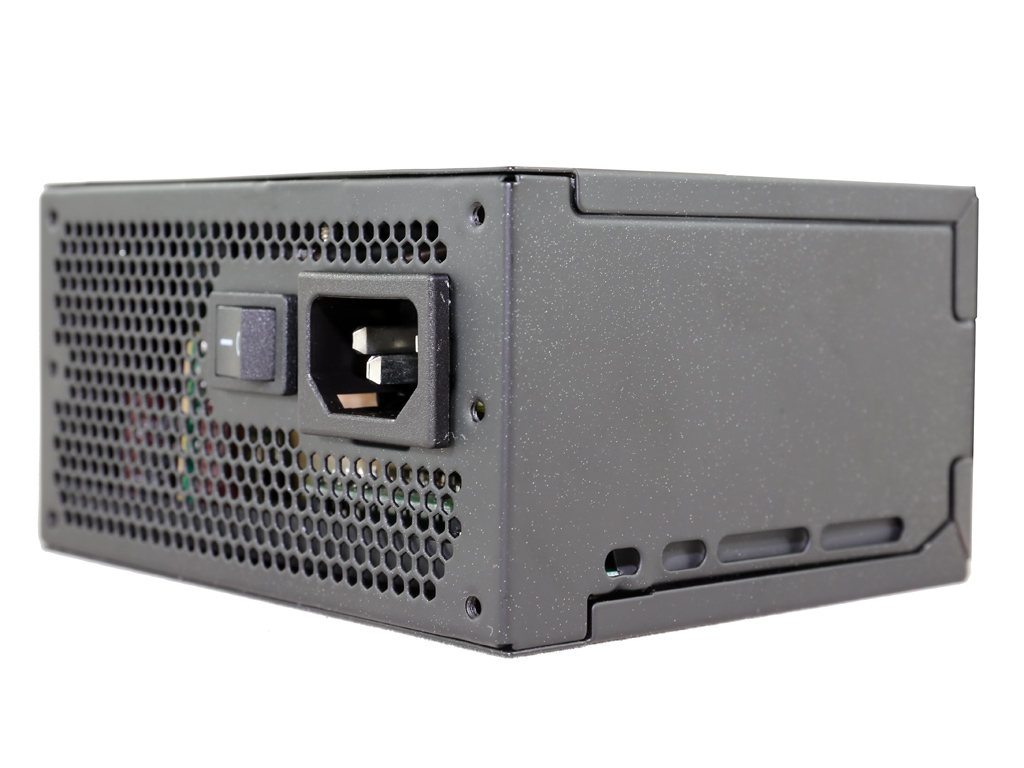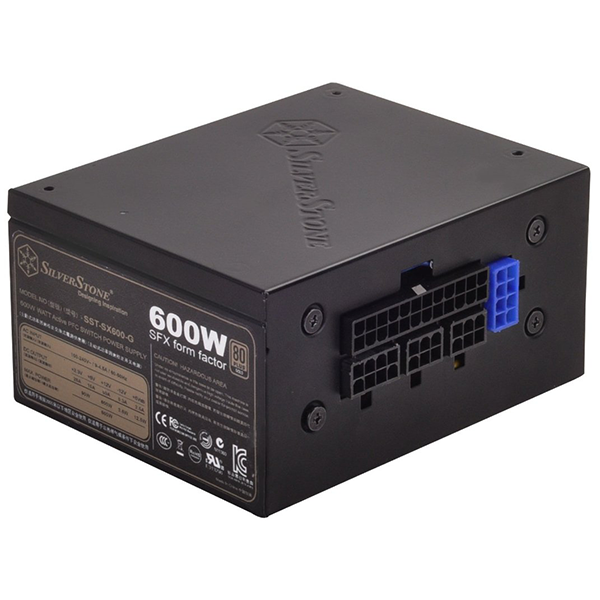SilverStone SX550 SFX PSU Review
SilverStone continues to enrich its SFX PSU portfolio. One of the most recent additions is the SX550, a budget-oriented unit featuring Gold-class efficiency and fixed cables instead of modular ones. As you can tell, it's intended to bring prices down.
Why you can trust Tom's Hardware
Load Regulation, Hold-Up Time And Inrush Current
To learn more about our PSU tests and methodology, please check out How We Test Power Supply Units.
Primary Rails And 5VSB Load Regulation
Load Regulation testing is detailed here.


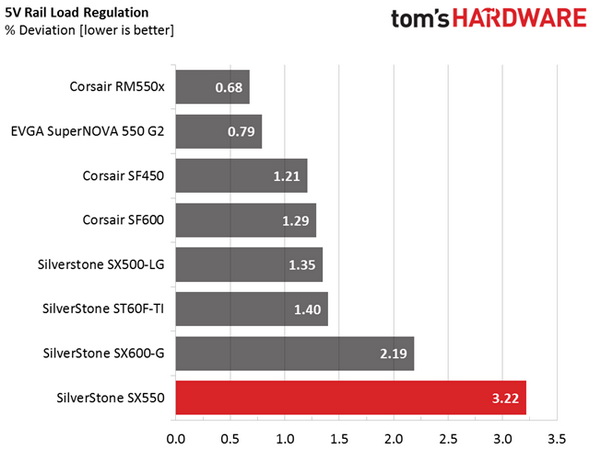

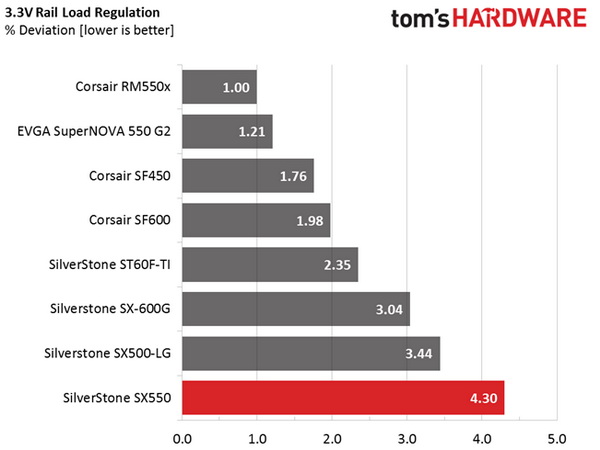



Hold-Up Time
Our hold-up time tests are described in detail here.
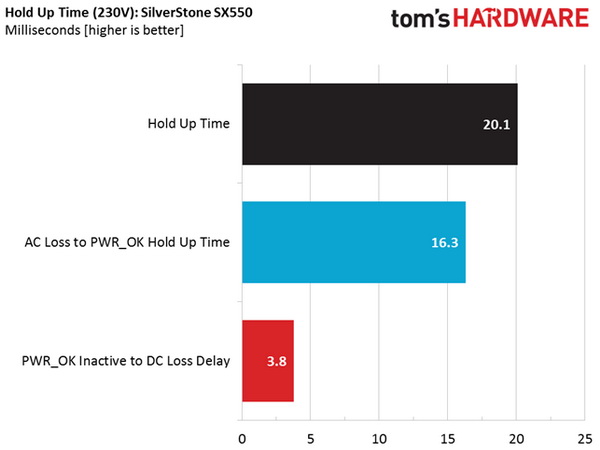






Despite the bulk caps' low combined capacity, the SX550's hold-up time easily surpass the ATX spec's requirement thanks to the ACRF topology. In addition, the power-good signal drops well before the rails go out of spec.
Inrush Current
For details on our inrush current testing, please click here.


Inrush current is normal with 115 V input and a little higher than expected with 230 VAC.
Load Regulation And Efficiency Measurements
Our first set of tests reveals the voltage rails' stability and the PSU's efficiency. The applied load equals (approximately) 10 to 110 percent of the power supply's maximum in increments of 10 percentage points.
Get Tom's Hardware's best news and in-depth reviews, straight to your inbox.
We conducted two additional tests. During the first, we stressed the two minor rails (5 V and 3.3 V) with a high load, while the load at +12V was only 0.1 A. This test reveals whether a PSU is Haswell-ready or not. In the second test, we determined the maximum load the +12V rail could handle with minimal load on the minor rails.
| Test # | 12 V | 5 V | 3.3 V | 5 VSB | DC/AC (Watts) | Efficiency | Fan Speed | Fan Noise | Temps (In/Out) | PF/AC Volts |
|---|---|---|---|---|---|---|---|---|---|---|
| 1 | 2.765A | 1.964A | 1.964A | 0.995A | 54.74 | 82.48% | 1495 RPM | 27.8 dB(A) | 39.75 °C | 0.971 |
| 12.002V | 5.081V | 3.359V | 5.007V | 66.37 | 44.02 °C | 115.1V | ||||
| 2 | 6.589A | 2.960A | 2.959A | 1.200A | 109.73 | 87.45% | 1495 RPM | 27.8 dB(A) | 39.83 °C | 0.982 |
| 11.970V | 5.063V | 3.343V | 4.988V | 125.48 | 44.66 °C | 115.1V | ||||
| 3 | 10.764A | 3.466A | 3.479A | 1.405A | 164.83 | 88.87% | 1690 RPM | 32.2 dB(A) | 40.94 °C | 0.991 |
| 11.961V | 5.051V | 3.331V | 4.970V | 185.48 | 46.05 °C | 115.1V | ||||
| 4 | 14.947A | 3.974A | 3.978A | 1.615A | 219.79 | 89.27% | 1860 RPM | 36.1 dB(A) | 41.53 °C | 0.996 |
| 11.949V | 5.034V | 3.316V | 4.949V | 246.22 | 46.97 °C | 115.1V | ||||
| 5 | 18.798A | 4.979A | 5.000A | 1.823A | 274.70 | 89.14% | 2140 RPM | 40.4 dB(A) | 42.22 °C | 0.998 |
| 11.929V | 5.017V | 3.298V | 4.931V | 308.17 | 47.82 °C | 115.1V | ||||
| 6 | 22.666A | 6.000A | 6.029A | 2.035A | 329.70 | 88.79% | 2560 RPM | 39.7 dB(A) | 43.27 °C | 0.998 |
| 11.909V | 5.000V | 3.282V | 4.908V | 371.32 | 49.04 °C | 115.1V | ||||
| 7 | 26.554A | 7.020A | 7.065A | 2.249A | 384.67 | 88.21% | 2810 RPM | 42.3 dB(A) | 43.90 °C | 0.999 |
| 11.886V | 4.981V | 3.268V | 4.887V | 436.09 | 49.99 °C | 115.1V | ||||
| 8 | 30.476A | 8.061A | 8.118A | 2.462A | 439.59 | 87.43% | 3140 RPM | 45.5 dB(A) | 44.15 °C | 0.999 |
| 11.852V | 4.963V | 3.252V | 4.867V | 502.81 | 50.52 °C | 115.1V | ||||
| 9 | 34.901A | 8.585A | 8.669A | 2.468A | 494.62 | 86.62% | 3345 RPM | 48.7 dB(A) | 44.75 °C | 0.999 |
| 11.806V | 4.951V | 3.241V | 4.854V | 571.00 | 51.58 °C | 115.1V | ||||
| 10 | 39.322A | 9.113A | 9.208A | 2.582A | 549.41 | 85.61% | 3345 RPM | 48.7 dB(A) | 45.90 °C | 0.999 |
| 11.755V | 4.937V | 3.225V | 4.838V | 641.76 | 53.85 °C | 115.1V | ||||
| 11 | 44.405A | 9.131A | 9.232A | 2.586A | 604.18 | 84.61% | 3345 RPM | 48.7 dB(A) | 46.50 °C | 0.999 |
| 11.643V | 4.929V | 3.216V | 4.826V | 714.06 | 55.02 °C | 115.1V | ||||
| CL1 | 0.097A | 14.021A | 14.002A | 0.000A | 116.14 | 80.91% | 2605 RPM | 40.0 dB(A) | 43.88 °C | 0.985 |
| 11.984V | 4.949V | 3.256V | 5.004V | 143.55 | 50.11 °C | 115.1V | ||||
| CL2 | 44.965A | 1.003A | 1.003A | 1.000A | 542.78 | 86.78% | 3345 RPM | 48.7 dB(A) | 46.12 °C | 0.999 |
| 11.776V | 5.013V | 3.296V | 4.938V | 625.45 | 54.14 °C | 115.1V |
Load regulation is mediocre on all rails and efficiency isn't particularly impressive under high operating temperatures. The SX550 manages to meet the 80 PLUS Gold requirements under 20 percent load. With 50 percent, it lands 0.86 percent away from the 90 percent target. The measurements get even worse under full load as efficiency drops below 86 percent. Obviously increased temperatures have a significant impact on the ACRF topology's performance.
With up to 20 percent load the fan's acoustic output is very low. Noise exceeds 40 dB(A), becoming noticeable especially to sensitive users, when the load level reaches 50 percent. With the fan spinning at close to 3350 RPM, the fan's noise doesn't exceed 50 dB(A). The fan profile definitely isn't aggressive, and the truth is that the small-diameter fan and moderate efficiency levels don't leave much room for a more relaxed ramp.
Current page: Load Regulation, Hold-Up Time And Inrush Current
Prev Page A Look Inside And Component Analysis Next Page Efficiency, Temperature And Noise
Aris Mpitziopoulos is a contributing editor at Tom's Hardware, covering PSUs.
-
turkey3_scratch It doesn't seem like Silverstone can get anything right these days. I don't see how they can't include a rubber grommet where the wires leave the cage. When people are bending those wires around the case, they can easily rub up against a sharp edge like that and cut through the insulation or even damage the wires and increase the resistance. For $95 this is a rip off, I think it should be priced at $75. It's pretty loud, too.Reply
Also, according to your thing the PS113 doesn't support OTP, even though this unit seems to. It also seems to support UVP. Doesn't quite make sense to me. http://www.tomshardware.com/reviews/power-supplies-101,4193-22.html -
Aris_Mp Most supervisor ICs don't support OTP, so this protection is implemented through other circuits in PSUs that actually have OTP.Reply -
Clamyboy74 Having few cables is the point of an sfx psu. Sfx cases don't have much driver space, and short wires are good for small cases. Who in their right mind would but an sfx psu for use in a mod tower case, especially with a $95 price tag? When you review sfx psu's please bear into consideration that these are made for use in small cases, where short cables, few connectors are deal breakers for consumers. Thank you.Reply -
turkey3_scratch The thing that hurts this unit is that there is no common hardware configuration that will fit into an SFX case and require more than a 400W power supply like the Corsair SF which is much better. Most high-end AMD GPUs like the R9 390 are just way too large to even fit into an SFX case. If you think of cards that can actually fit into an SFX case, they are going to be small form factor cards, which are almost always under 200W, or these days even quite less. CPU overclocking to extremes can't be done in SFX cases with limited cooler sizes and due to airflow restrictions, so, really, I don't see a position in the market where this unit can be competitive over the Corsair SF400. And since this unit does not come with an SFX to ATX bracket, it is implied that nobody will probably install it into a case that takes an ATX PS2 power supply.Reply -
AlistairAB I have the corsaif sf450 and can confirm it blows the silverstone out of the water (silverstone never fixed their fan problems with their sfx psus)Reply -
Samer1970 Reply18459920 said:The thing that hurts this unit is that there is no common hardware configuration that will fit into an SFX case and require more than a 400W power supply like the Corsair SF which is much better. Most high-end AMD GPUs like the R9 390 are just way too large to even fit into an SFX case. If you think of cards that can actually fit into an SFX case, they are going to be small form factor cards, which are almost always under 200W, or these days even quite less. CPU overclocking to extremes can't be done in SFX cases with limited cooler sizes and due to airflow restrictions, so, really, I don't see a position in the market where this unit can be competitive over the Corsair SF400. And since this unit does not come with an SFX to ATX bracket, it is implied that nobody will probably install it into a case that takes an ATX PS2 power supply.
how about Titan X Pascal cards / 1080 ti? They consume 435Watt total System power.
-
turkey3_scratch Not quite samer and not cards that would fit in an SFX case.Reply
Also, my bad guys, I meant SF450 not 400. -
Samer1970 Reply18460559 said:Not quite samer and not cards that would fit in an SFX case.
Also, my bad guys, I meant SF450 not 400.
maybe you should check the following cases :
http://www.fractal-design.com/home/product/cases/node-series/node-202
http://www.silverstonetek.com/product.php?pid=533
http://www.silverstonetek.com/raven/products/index.php?model=RVZ02
https://www.ncases.com/
https://www.dan-cases.com/ -
turkey3_scratch If you own a 1080Ti why would you get a mediocre PSU like this anyway? Once again, it doesn't seem to have a purpose at all. Once power requirements get anywhere past 300W you probably have high-end hardware in which case a unit like this is a poor choice over the SF600.Reply
Budget power supplies over 500W really have no place in this world. People purchase budget power supplies over 500W for three reasons:
1) They have high end hardware and underestimate the need for a quality PSU
2) They are uninformed and think "more watts" is better.
3) They overestimate their power requirements.
I suppose you could argue if they have 225W of hardware a 550W unit like this is perfect in terms of efficiency. Okay, maybe so. But that depends on how much you value efficiency, I suppose.
The unit still performs poorly compared to Corsair. It's true, Corsair SF dominate the SFX market with the best units. -
Samer1970 Reply18460649 said:If you own a 1080Ti why would you get a mediocre PSU like this anyway? Once again, it doesn't seem to have a purpose at all. Once power requirements get anywhere past 300W you probably have high-end hardware in which case a unit like this is a poor choice over the SF600.
Budget power supplies over 500W really have no place in this world. People purchase budget power supplies over 500W for three reasons:
1) They have high end hardware and underestimate the need for a quality PSU
2) They are uninformed and think "more watts" is better.
3) They overestimate their power requirements.
I suppose you could argue if they have 225W of hardware a 550W unit like this is perfect in terms of efficiency. Okay, maybe so. But that depends on how much you value efficiency, I suppose.
The unit still performs poorly compared to Corsair. It's true, Corsair SF dominate the SFX market with the best units.
Does not need to be 1080 ti , any 250 watt GPU card ... from 390 , 390x to others .. there are people on budget and use such cards in compact systems .
I just mentioned gtx 1080 ti as a modern example ..
